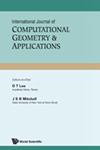正交多边形信标路由的组合界
Q4 Mathematics
International Journal of Computational Geometry & Applications
Pub Date : 2015-07-13
DOI:10.20382/jocg.v13i1a2
引用次数: 11
摘要
信标吸引是一种运动系统,机器人(建模为2D中的点)在自由空间中移动,以便始终在局部最小化其与激活信标(也是一个点)的欧氏距离。这导致机器人在可能的情况下直接向信标移动,否则会沿着障碍物的边缘滑动。当机器人可以通过这种方法到达激活的信标时,我们说信标吸引机器人。从$p$到$q$的信标路由是一个序列$b_1, b_2,$…, $b_{k}$的信标,这样按顺序激活信标将吸引机器人从$p$到$b_1$再到$b_2$…从$b_{k}$到$q$,其中$q$被认为是一个信标。信标的路由集是信标的集合$B$,使得自由空间中任意两点$p, q$具有具有中间信标$b_1, b_2,$…的信标路由。, $b_{k}$全部选自$B$。在这里,我们解决了正交多边形中“这样的$B$必须有多大?”的问题,并表明答案“有时与$[(n-4)/3]$一样大,但永远不会更大”。本文章由计算机程序翻译,如有差异,请以英文原文为准。
A Combinatorial Bound for Beacon-based Routing in Orthogonal Polygons
Beacon attraction is a movement system whereby a robot (modeled as a point in 2D) moves in a free space so as to always locally minimize its Euclidean distance to an activated beacon (which is also a point). This results in the robot moving directly towards the beacon when it can, and otherwise sliding along the edge of an obstacle. When a robot can reach the activated beacon by this method, we say that the beacon attracts the robot. A beacon routing from $p$ to $q$ is a sequence $b_1, b_2,$ ..., $b_{k}$ of beacons such that activating the beacons in order will attract a robot from $p$ to $b_1$ to $b_2$ ... to $b_{k}$ to $q$, where $q$ is considered to be a beacon. A routing set of beacons is a set $B$ of beacons such that any two points $p, q$ in the free space have a beacon routing with the intermediate beacons $b_1, b_2,$ ..., $b_{k}$ all chosen from $B$. Here we address the question of "how large must such a $B$ be?" in orthogonal polygons, and show that the answer is "sometimes as large as $[(n-4)/3]$, but never larger."
求助全文
通过发布文献求助,成功后即可免费获取论文全文。
去求助
来源期刊
CiteScore
0.80
自引率
0.00%
发文量
4
审稿时长
>12 weeks
期刊介绍:
The International Journal of Computational Geometry & Applications (IJCGA) is a quarterly journal devoted to the field of computational geometry within the framework of design and analysis of algorithms.
Emphasis is placed on the computational aspects of geometric problems that arise in various fields of science and engineering including computer-aided geometry design (CAGD), computer graphics, constructive solid geometry (CSG), operations research, pattern recognition, robotics, solid modelling, VLSI routing/layout, and others. Research contributions ranging from theoretical results in algorithm design — sequential or parallel, probabilistic or randomized algorithms — to applications in the above-mentioned areas are welcome. Research findings or experiences in the implementations of geometric algorithms, such as numerical stability, and papers with a geometric flavour related to algorithms or the application areas of computational geometry are also welcome.

 求助内容:
求助内容: 应助结果提醒方式:
应助结果提醒方式:


